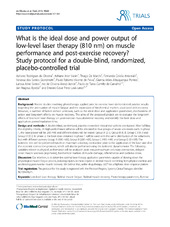| dc.contributor.author | de Oliveira, Adriano Rodrigues | en_US |
| dc.contributor.author | Vanin, Adriane Aver | en_US |
| dc.contributor.author | De Marchi, Thiago | en_US |
| dc.contributor.author | Antonialli, Fernanda Colella | en_US |
| dc.contributor.author | Grandinetti, Vanessa dos Santos | en_US |
| dc.contributor.author | de Paiva, Paulo Roberto Vicente | en_US |
| dc.contributor.author | Albuquerque Pontes, Gianna Móes | en_US |
| dc.contributor.author | Santos, Larissa Aline | en_US |
| dc.contributor.author | Aleixo Junior, Ivo de Oliveira | en_US |
| dc.contributor.author | de Carvalho, Paulo de Tarso Camillo | en_US |
| dc.contributor.author | Bjordal, Jan Magnus | en_US |
| dc.contributor.author | Leal Junior, Ernesto Cesar Pinto | en_US |
| dc.date.accessioned | 2014-03-06T16:32:26Z | |
| dc.date.available | 2014-03-06T16:32:26Z | |
| dc.date.issued | 2014-02-27 | eng |
| dc.identifier.issn | 1745-6215 | |
| dc.identifier.uri | https://hdl.handle.net/1956/7844 | |
| dc.description.abstract | Background: Recent studies involving phototherapy applied prior to exercise have demonstrated positive results regarding the attenuation of muscle fatigue and the expression of biochemical markers associated with recovery. However, a number of factors remain unknown, such as the ideal dose and application parameters, mechanisms of action and long-term effects on muscle recovery. The aims of the proposed project are to evaluate the long-term effects of low-level laser therapy on post-exercise musculoskeletal recovery and identify the best dose and application power/irradiation time. Design and methods: A double-blind, randomized, placebo-controlled clinical trial with be conducted. After fulfilling the eligibility criteria, 28 high-performance athletes will be allocated to four groups of seven volunteers each. In phase 1, the laser power will be 200 mW and different doses will be tested: Group A (2 J), Group B (6 J), Group C (10 J) and Group D (0 J). In phase 2, the best dose obtained in phase 1 will be used with the same distribution of the volunteers, but with different powers: Group A (100 mW), Group B (200 mW), Group C (400 mW) and Group D (0 mW). The isokinetic test will be performed based on maximum voluntary contraction prior to the application of the laser and after the eccentric contraction protocol, which will also be performed using the isokinetic dynamometer. The following variables related to physical performance will be analyzed: peak torque/maximum voluntary contraction, delayed onset muscle soreness (algometer), biochemical markers of muscle damage, inflammation and oxidative stress. Discussion: Our intention, is to determine optimal laser therapy application parameters capable of slowing down the physiological muscle fatigue process, reducing injuries or micro-injuries in skeletal muscle stemming from physical exertion and accelerating post-exercise muscle recovery. We believe that, unlike drug therapy, LLLT has a biphasic dose–response pattern. | en_US |
| dc.language.iso | eng | eng |
| dc.publisher | BioMed Central | eng |
| dc.rights | Attribution CC BY | eng |
| dc.rights.uri | http://creativecommons.org/licenses/by/2.0/ | eng |
| dc.subject | Low-level laser therapy | eng |
| dc.subject | Skeletal muscle fatigue | eng |
| dc.subject | Skeletal muscle recovery | eng |
| dc.subject | Phototherapy parameters | eng |
| dc.subject | Exercise | eng |
| dc.title | What is the ideal dose and power output of low-level laser therapy (810 nm) on muscle performance and post-exercise recovery? Study protocol for a double-blind, randomized, placebo-controlled trial | en_US |
| dc.type | Peer reviewed | |
| dc.type | Journal article | |
| dc.date.updated | 2014-03-06T16:07:44Z | |
| dc.description.version | publishedVersion | en_US |
| dc.rights.holder | Copyright 2014 de Oliveira et al.; licensee BioMed Central Ltd. | |
| dc.rights.holder | Adriano Rodrigues de Oliveira et al.; licensee BioMed Central Ltd. | |
| dc.source.articlenumber | 69 | |
| dc.identifier.doi | https://doi.org/10.1186/1745-6215-15-69 | |
| dc.identifier.cristin | 1148688 | |
| dc.source.journal | Trials | |
| dc.source.40 | 15 | |

